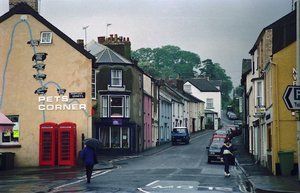Advertisement
Published: August 12th 2009

 Chudleigh
Chudleigh
Chudleigh is located near the perimeter of the Dartmoor.Rain accompanies me on my journey from Exeter to the Dartmoor. First I take a little coastal detour to Dawlish where a cottage pie is devoured for Lunch. The village of
Chudleigh, located near the perimeter of the Dartmoor is considered worthy of exploration.
Located in southern Devon the
Dartmoor covers 950 sq kms. It is noted for tors, which are large hills topped with outcrops of bedrock. Observing from the top of one of these tors the Dartmoor appears to have two types of surface. One surface is wilderness while the another is farming fields which appear to be separated by hedges. On closer inspection the hedges are heath bounded roads. Some have trees with over arching branches which enclose the road.
Many villages within the Dartmoor are built of stone. An example is
Wildcombe-in-the-Moor. This village is noted for St Pancras church with it 120 feet high tower. Partially financed by the local tin mining industry, it was originally built in the 14th century. During a thunder storm in 1638 part of the tower collapsed onto the parishioners killing four of them. It is believed that the construction material, porous granite which is very vulnerable to weathering

 Dartmoor
Dartmoor
From the top of a tor overlooking Wildcombe-in-the-Moor.contributed to the collapse.
It is said that 8.3 million people visit the Dartmoor every year, but on this rainy day I appear to have exclusive access to its moors!
The night is spend in Exeter discussing philosophy and literature with a Dutch girl who said she wanted to be a journalist. Oh really, what on earth do I know about philosophy and literature?
Today, another Sunday, the objective is Penzance via
Launceston. Have to go to Launceston to compare it to its namesake in Tasmania. Surprise, surprise both are on the River Tamar. This Launceston was founded in 1068 when King William I built a timber and earth castle to keep an eagle eye on his less than totally loyal Anglo-Saxon subjects. From this castle both the Dartmoor and the Bodmin Moor can be viewed. According to the Domesday Book the property was owned by Count Robert Mortain. A stone castle was built in the 13th century when Richard, Earl of Cornwall (1227-71) remodeled the defenses. It gained the name, Castle Terrible, because the castle greens were used for public executions until the 19th century. The great hall built in the 13th century was demolished in

 Launceston Castle
Launceston Castle
Stone castle built in the 13th century.the 16th century. When the North Gate in 1762 it was converted into a county gaol. All that remains today is the walls and shell of the 13th century. Launceston enjoyed a reasonable standard of living as shown by pottery, glazed jugs and glass windows. The population of Launceston, Cornwall is 5000-7000. I thought that would be equivalent or larger than its Tasmanian namesake which has a population of around 80,000. Though spelled the same, the pronunciation of this town's name is "Lant-sing" rather than "Lawn-ces-ton".
Reaching the coast I stop at the village of
Polperro. Traditionally its main industry has been fishing. Pilchards were caught and processed, the oil being used for heating and lighting. However by the 1960's the shoal had been fished out. Another traditional industry was smuggling, which reached its height during the American War of Independence. Today, though there is still some fishing, for flat fish, cod and crab, its main industry is tourism. Quite pretty but perhaps a little bit too touristy for my taste. My attitude was re-enforced by a declaration on a donation box that they were self-supporting, wanted to remain so without further commerialisation, and that my donation would

 Polperro
Polperro
on the Cornwall coast. Traditionally fishing has been the main industry but today it is tourism.help.
Continuing on to
Penzance I cross the river at Fawley using the punt. It cost me one pound and 20p which I thought was excessive, but there was no sign and they asked me for the money when I was half-way across.
After spending a night in Penzance my first thought today was to travel to Land End's, the most western tip of Britain. A charge of four pound & 50p causes me to reconsider. Somewhat peeved I make my way to Marazion via Mousehole and Penzance. Here on a rocky island just 400 yards off the shore is today's highlight,
St Michael's Mount. If the tide is out or low it can be reached by a causeway. But now, because the tide is in, I have to use a boat. Originally a Benedictine monastery it was converted into a fortress. The Spanish Armada was sighted from here in 1588. The Armada revisited in 1590 and 1595 burning Mousehole and Penzance to the ground. Gee, they didn't tell us that in our history lessons! Cromwell tried to storm it during the English Civil War. After the civil war the island was purchased by the St Aubyn family

 St Michael's Mont
St Michael's Mont
is located 400 meters off the Cornish Coast at Marazion.who still reside. Inside are relics, mainly armour and antique furniture. Outside, facing Marazion, are a few houses with water supplied by a spring on the island. An artificial habour has been built which can accommodate ships up to 500 tons.
Tonight I stay near
Tintagel on the rugged coast of King Authur Country.
Advertisement
Tot: 0.143s; Tpl: 0.012s; cc: 13; qc: 61; dbt: 0.0606s; 1; m:domysql w:travelblog (10.17.0.13); sld: 1;
; mem: 1.2mb








